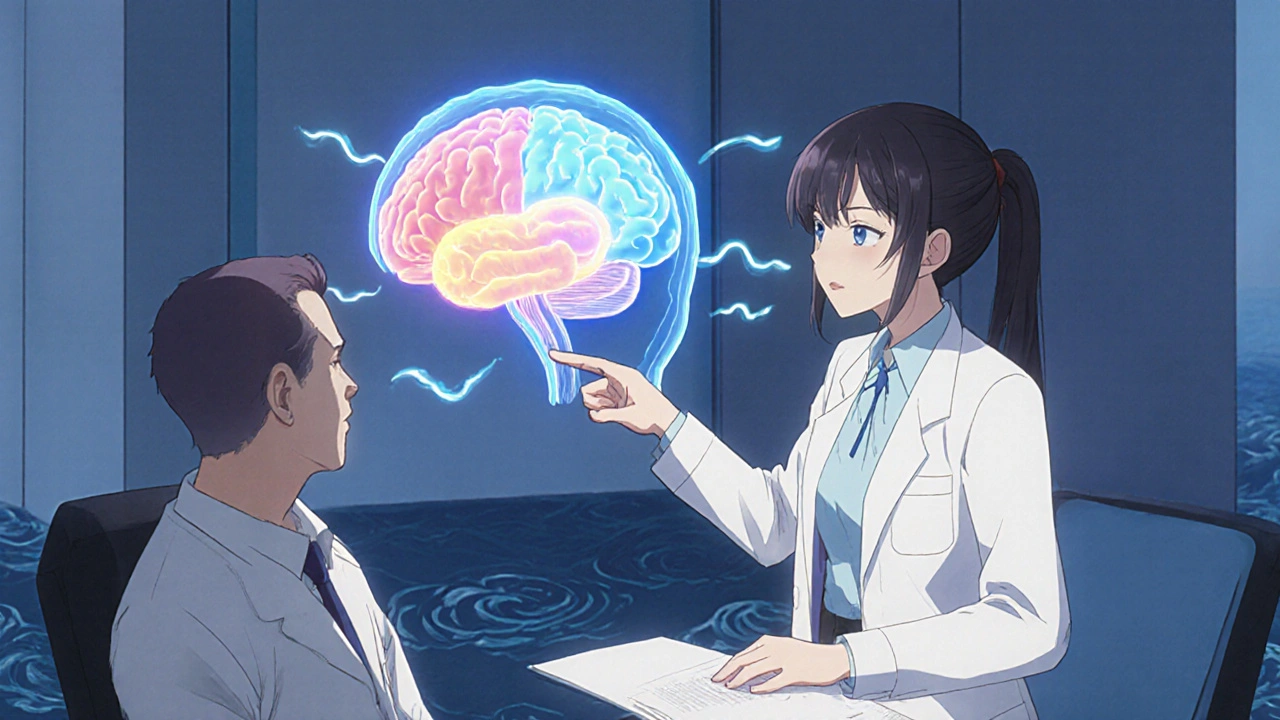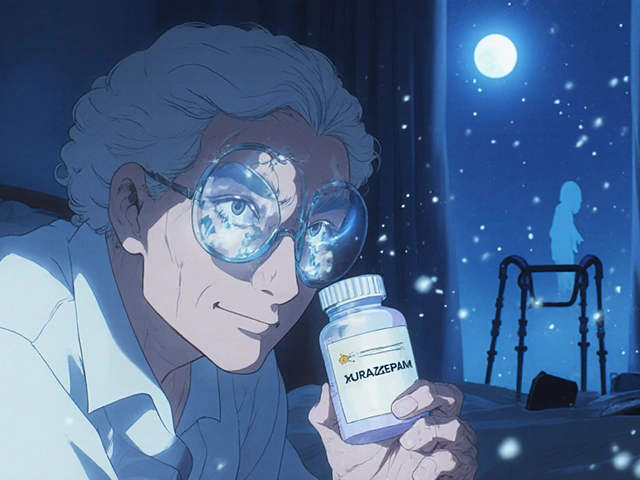
Health November 20, 2025
Tinnitus Retraining Therapy: How Habituation and Sound Therapy Reduce Tinnitus Distress
Most people with tinnitus are told to just live with it. That’s not helpful. You hear a ringing, buzzing, or hissing sound every day-sometimes all day-and it steals your focus, ruins your sleep, and makes you anxious. But what if the goal isn’t to make the sound disappear? What if the real problem isn’t the noise itself, but your brain’s reaction to it?
Why Tinnitus Feels So Bad
Tinnitus isn’t a disease. It’s a symptom. Your ears aren’t broken. Your brain is just stuck in a loop. When the auditory system gets damaged-by loud noise, aging, or medication-it sends out random signals. Normally, your brain filters these out like background hum from a fridge. But for some people, the brain labels those signals as dangerous. The amygdala (your fear center) and the autonomic nervous system kick in. Suddenly, tinnitus isn’t just noise. It’s a threat. And your body responds with stress, sleeplessness, and panic. This isn’t in your head. It’s in your brain’s wiring. Brain scans show stronger connections between the hearing areas and the emotional centers in people with distressing tinnitus. The louder the sound feels, the more your brain is amplifying it-not because it’s physically louder, but because your nervous system is screaming at you to pay attention.What Is Tinnitus Retraining Therapy (TRT)?
Tinnitus Retraining Therapy, or TRT, was developed in the 1990s by Dr. Pawel Jastreboff. It’s not a cure. It’s not a magic device. It’s a science-backed method to retrain your brain so tinnitus stops being a problem. TRT doesn’t try to silence the sound. It teaches your brain to ignore it-like you ignore the feeling of your socks or the ticking of a clock. TRT works because of something called habituation. That’s the brain’s natural ability to stop reacting to constant, harmless stimuli. You don’t notice your watch after an hour. You don’t hear your own breathing. TRT uses that same principle to help you stop noticing tinnitus-not because it’s gone, but because your brain no longer cares.The Two Pillars of TRT: Counseling and Sound Therapy
TRT has two parts, and one is way more important than the other. Counseling is the foundation. It’s not therapy in the talk-therapy sense. It’s education. You sit with an audiologist who’s trained in TRT, and they explain exactly how tinnitus works. They show you diagrams of the ear, the auditory nerve, the limbic system. They tell you: This sound isn’t a warning. It’s just noise your brain misfired. It’s not dangerous. It doesn’t mean something’s getting worse. This isn’t just reassurance. It’s rewiring. When you understand that tinnitus isn’t a threat, your brain stops triggering fear responses. Studies show counseling alone accounts for 60-70% of TRT’s success. Without it, sound therapy doesn’t work as well. Sound therapy is the second piece. It’s not about masking tinnitus with loud music or white noise. It’s about using low-level, non-intrusive sound-like gentle static or ocean waves-to slightly reduce the contrast between your tinnitus and the background noise in your environment. Think of it like dimming the lights in a dark room. If the room is pitch black and you see a tiny light, you can’t look away. But if you turn on a soft lamp, that same light becomes invisible. The sound is delivered through small devices worn in the ears, or through hearing aids if you have hearing loss. You wear them for 6-8 hours a day while awake. The volume is set just below your tinnitus level-not loud enough to cover it, but enough to make it less prominent. Over time, your brain starts to treat the tinnitus signal as background noise, just like the hum of a refrigerator.
Who Gets TRT? The Four Patient Groups
TRT isn’t one-size-fits-all. Patients are grouped based on hearing status and tinnitus characteristics:- Group 1: Normal hearing, tinnitus only → uses sound generators only
- Group 2: Hearing loss, no tinnitus awareness in quiet → uses hearing aids only
- Group 3: Hearing loss + tinnitus → uses hearing aids + sound generators
- Group 4: Tinnitus + sensitivity to everyday sounds (hyperacusis) → uses customized protocols
How Long Does It Take?
TRT isn’t quick. It’s not a 10-day app. It’s a 12- to 24-month process. You’ll have monthly appointments at first, then every few months. The counseling sessions are long-60 to 90 minutes. The sound therapy? You have to wear it daily, every waking hour. That’s why dropout rates are high. About 30-40% of people quit before finishing. It’s tedious. It’s hard to stay motivated when you don’t feel better right away. But those who stick with it? 80% report major improvement. They still hear the sound-but it doesn’t bother them. They notice it only 5-15% of the day, compared to 80-100% before.Is TRT Better Than Other Treatments?
There are two evidence-based treatments for tinnitus: TRT and Cognitive Behavioral Therapy (CBT). Both are backed by strong clinical data. CBT focuses on changing thought patterns and managing anxiety. TRT focuses on rewiring the brain’s automatic response. A 2019 review in JAMA Otolaryngology found TRT led to significantly greater improvement in tinnitus symptoms than standard care. But here’s the catch: TRT only works if done right. Only 15-20% of audiologists in the U.S. are certified in the full Jastreboff protocol. Many clinics offer “TRT-like” programs using sound generators and brief counseling-but without the full neurophysiological model, success drops to 55%. If you’re considering TRT, ask: Is the provider certified by the Jastreboff Foundation? If not, you’re not getting real TRT.
Cost, Accessibility, and the Future
TRT isn’t cheap. In the U.S., the full program costs $2,500-$4,000. Sound generators run $500-$1,200. Insurance rarely covers it. That’s why many people never try it. But things are changing. In 2021, the Jastreboff Foundation launched a telehealth certification program. More clinics are now offering virtual counseling. A 2023 trial combining TRT with transcranial magnetic stimulation showed 92% improvement at six months-faster than TRT alone. Right now, there are only about 500 certified TRT providers in the U.S. But 65% of major hearing centers now use at least some TRT principles in their tinnitus care. That’s progress.What Success Really Looks Like
Success isn’t silence. Success is freedom. Someone who’s completed TRT still hears tinnitus. But they don’t jump when they hear it. They don’t lie awake worrying about it. They don’t avoid quiet rooms or social events. They can focus at work. They sleep through the night. The sound is there-but it’s background. Just like the air conditioner. Just like the fridge. It’s not about making the noise go away. It’s about making it irrelevant.Is TRT Right for You?
TRT works best if:- You’ve had tinnitus for more than 6 months
- You’re willing to commit to 12-24 months
- You can afford the time and cost
- You’re open to learning how your brain works
Can TRT completely eliminate tinnitus?
No. TRT doesn’t remove the sound. It changes how your brain reacts to it. Most people still hear tinnitus after treatment-but they no longer find it disturbing. The goal is habituation, not elimination.
How long until I see results from TRT?
Most people start noticing changes after 6-8 months. Significant improvement usually takes 12-18 months. It’s a slow process because you’re rewiring deep brain pathways, not just masking symptoms.
Do I need hearing aids for TRT?
Only if you have hearing loss. If your hearing is normal, you’ll use sound generators. If you have hearing loss, you’ll use hearing aids with built-in sound generators. The device is chosen based on your specific hearing profile.
Can I do TRT at home without a specialist?
Not effectively. The counseling component is critical and requires training in the neurophysiological model. Buying sound generators online won’t give you the same results. Without proper guidance, you risk using the wrong sound levels or missing key educational steps.
Is TRT covered by insurance?
Rarely. Most insurance plans don’t cover TRT counseling or sound generators because they’re considered experimental or non-essential. Some patients use HSA or FSA funds. Always check with your provider.
What if TRT doesn’t work for me?
TRT has an 80% success rate when done correctly. If you don’t improve, it’s likely due to incomplete implementation-not because the method doesn’t work. Talk to your provider about adjusting the protocol. Cognitive Behavioral Therapy (CBT) is another evidence-based option that may help.
Write a comment
Items marked with * are required.






12 Comments
Kartik Singhal November 22, 2025 AT 18:19
Okay but let’s be real - this is just Big Audiologist’s way to sell $1200 sound generators while charging $4k for ‘counseling’ that’s just a PowerPoint on the limbic system. 🤡 I’ve got a $10 app that plays ocean waves and my tinnitus hasn’t bothered me since I stopped believing it’s a ‘threat’. Wake up, sheeple.
Logan Romine November 23, 2025 AT 00:28
Ah yes, the sacred ritual of brain retraining. You don’t cure the noise, you just convince yourself it’s not worth caring about. Like when you stop noticing your own body odor. Philosophically elegant. Practically? A glorified placebo wrapped in neuro jargon. 🧠✨
Shawn Sakura November 23, 2025 AT 20:31
I know it sounds slow, but I did TRT for 18 months and I’m not gonna lie - it changed my life. I used to cry in the shower from the ringing. Now? I hear it while I’m making coffee and just shrug. It’s there, but it’s not ME anymore. You don’t need to believe in it to try it - just show up. 🙏
Simone Wood November 24, 2025 AT 03:36
I tried this. I did. But after 8 months of wearing those stupid ear things and listening to audiologists drone on about amygdala pathways, I realized something: the whole thing was designed to keep me dependent. They don’t want you cured. They want you coming back for ‘adjustments’. I stopped. Now I just wear noise-canceling headphones and pretend I’m in a James Bond movie. 🎧💥
Swati Jain November 25, 2025 AT 04:18
If you’re still reading this and thinking ‘this is too much work’ - I get it. But hear me: your brain is a muscle. You wouldn’t skip leg day and expect to run a marathon. TRT is leg day for your nervous system. It’s boring. It’s tedious. But it works. And you’re worth the effort. 💪
Florian Moser November 26, 2025 AT 05:19
I’m a certified TRT provider and I can confirm: the 80% success rate is real - but only if you follow the full Jastreboff protocol. I’ve seen people waste thousands on ‘TRT-like’ programs that skip counseling. It’s like buying a Ferrari and only driving it in first gear. Don’t cut corners. Find a certified provider. It matters.
jim cerqua November 27, 2025 AT 19:04
I’m not saying this is a scam, but I’ve seen people spend $3000 and still end up in therapy for PTSD because their tinnitus ‘triggered’ a childhood trauma they never dealt with. This isn’t brain retraining - it’s emotional avoidance with a sound generator. The real issue? We’ve outsourced healing to gadgets because we’re too scared to face the silence - and what’s underneath it.
Donald Frantz November 28, 2025 AT 10:01
Has anyone actually replicated the Jastreboff studies with double-blind controls? I’ve read the JAMA paper, but the sample sizes were small and the control groups were just ‘standard care’ - which is basically ‘take a melatonin and stop Googling’. Where’s the placebo-controlled trial with fMRI evidence? I’m not dismissing it - I just want the data.
Sammy Williams November 29, 2025 AT 08:25
I did TRT. It sucked. I hated the devices. I thought I was wasting my time. But then one day I realized I’d been reading a book for an hour and didn’t notice the ringing once. That’s when I knew. It’s not magic. It’s just… quiet. And that’s enough.
Julia Strothers November 29, 2025 AT 13:53
This is just the medical-industrial complex preying on vulnerable people. They know you’re desperate. So they sell you a $4000 ‘cure’ that’s just noise + a lecture. Meanwhile, the real cause? EMF from 5G towers and glyphosate in your coffee. But hey, wear your little ear buds and pretend it’s science. 🤖🇨🇳
Erika Sta. Maria November 30, 2025 AT 03:46
Wait - so the brain ‘filters’ tinnitus like a fridge? But then why do I hear it louder when I’m stressed? And why do I hear it more in quiet rooms? If it’s just habituation, why does it come and go? This whole thing feels like someone took a neuroscience textbook and mashed it with a self-help blog. Also, I think ‘amygdala’ is spelled wrong in the post. 🤔
Nikhil Purohit December 1, 2025 AT 08:15
I’ve had tinnitus for 7 years. Tried everything - supplements, acupuncture, meditation, even a weird Tibetan singing bowl app. TRT was the only thing that didn’t make me feel like a guinea pig. I’m 14 months in. Still hear it. But now I can sleep. And that’s the win. No hype. Just patience.